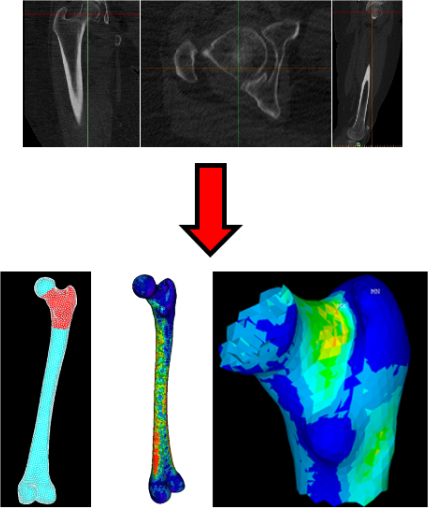About the Service
Detailed information regarding the service and the modelling pipeline:
Non-invasive bone strength estimation
The CT2S service provides an estimate of the strength of human bone, using non-invasive medical imaging. A user uploads a computed tomography (CT) scan of the anatomy, and receives back a set of values that characterise the strength of the bone under a series of common loading conditions.
The service operates by creating a patient-specific finite element model of the bone, using a state of the art image-processing pipeline. This very precise model of the patient's anatomy is then examined under a range of highly realistic simulated loading conditions, including walking, running, stair-climbing and falling, and the fracture load is computed in each case. Data summarising the identified fracture strength is returned to the user.
Bone strength is clinically important in many circumstances, as an indicator of health - particularly in the ageing population, in fracture risk assessment to stratify patients for prophylaxis, and in efficacy determination for both physiotherapeutic and pharmacological interventions. Until now however, strength could only be measured destructively, and clinical practice has been obliged to rely on surrogate biomarkers, typically areal Bone Mineral Density (aBMD) derived from dual energy X-ray absorptiometry. This measure, although relevant to bone characterisation, is in practice a poor predictor of bone strength.
CT-based finite element models have been shown to predict bone strength with excellent accuracy in vitro and the technique has now been further developed and optimised in CT2S to operate with in vivo data. With its superior accuracy in predicting strength, CT2S has already been shown both to be a superior tool in fracture risk assessment, and to reduce almost by half the size of the cohorts required for clinical trials investigating interventions.
The service is applicable to all human long bones. We highly recommend CT2S for use in all clinical trials requiring assessment of bone strength.
The CT2S Service

About the service
Detailed information regarding the service and the modelling pipeline can be accessed through these documents. Interested clients would need to provide the following information:
- Anonymised CT scan of the patient
- CT scan of European spine phantom (ESP)
Please refer to the documents for specifications of the CT protocol and contact us for clarifications and planning the study.